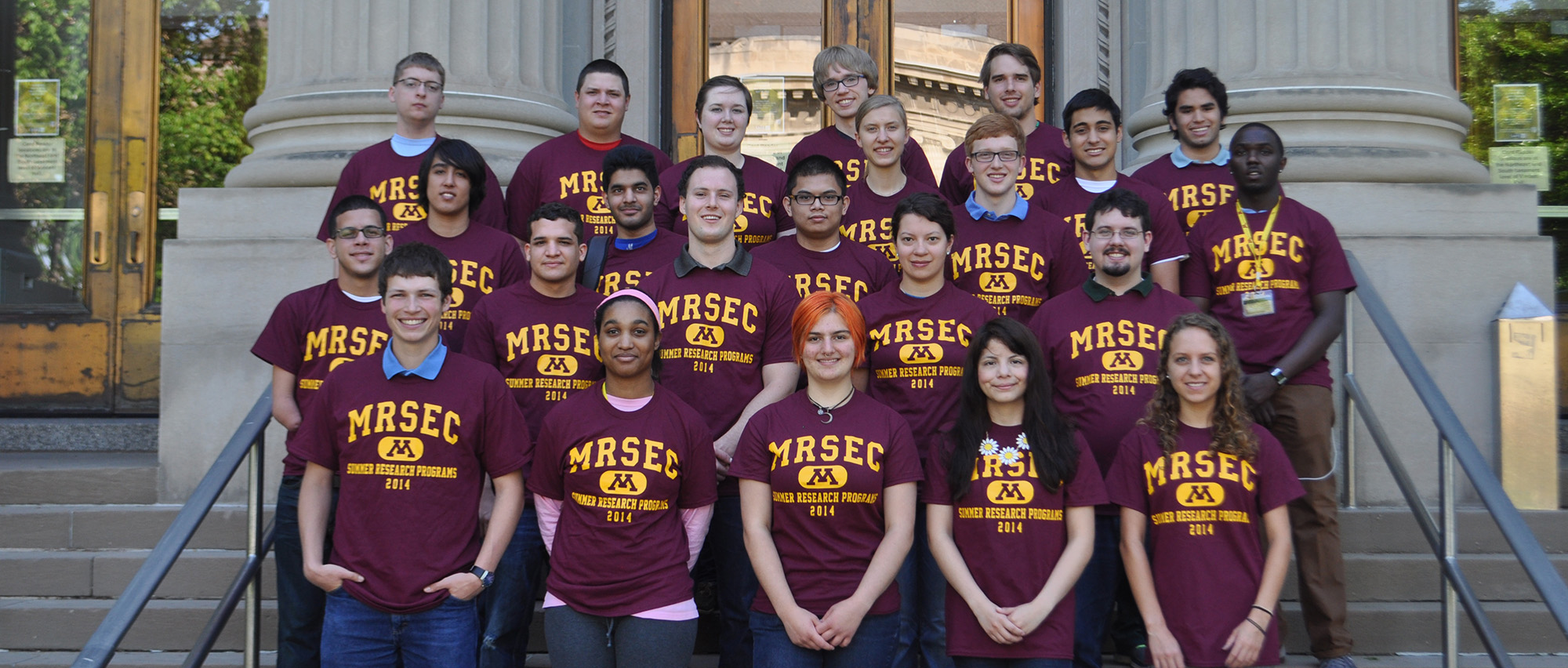

Home Institution: University of Minnesota- Duluth
Major/Minor: Electrical Engineering
MRSEC Mentor: Steve Koester
Effective removal of poly(methyl methacrylate) film from chemical vapor deposited graphene
Graphene, which is a one atom thick material made of carbon, has been found to have extraordinary physical properties. For instance, graphene has been found to have very high electron mobility and thermal conductivity. Graphene has been produced using methods such as chemical vapor deposition (CVD), mechanical exfoliation, and chemical synthesis. The removal of poly(methyl methacrylate) (PMMA) film from CVD graphene has been a critical step in the process of producing quality graphene. The sole purpose of PMMA is to provide a rigid surface as the graphene is transferred to a substrate such as SiO2/Si. Once the PMMA has served its purpose it will need to be removed. PMMA residue has been found to be substantially responsible for p-type doping in CVD graphene. Therefore, the effective removal is of great importance. The process used to remove the PMMA film will include a glacial acetic acid treatment, thermal annealing in an Ar/H2 gas mixture, and exposure to UV light at a wavelength of 253.7nm. The samples will then undergo atomic force microscope characterization to determine the optimal amount of time the samples need to undergo thermal annealing, glacial acetic acid treatment, and UV light exposure to effectively remove the PMMA residue.
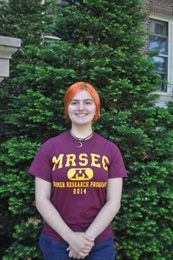
Home Institution: Tulane
Major/Minor: Chemical Engineering & Music
MRSEC Mentor: Marc Hillmyer
Molecular Bottlebrushes in Multiblock Copolymers
Molecular bottlebrushes consist of a polymeric backbone with densely grafted side chains, giving it the physical appearance of a bottlebrush. Block copolymers exist when two chemically distinct, but not necessarily dissimilar, polymers are “stitched” together. The two polymers will repel each other and in turn, these copolymers will self-assemble into well defined structures. My research will explore how molecular bottlebrushes act when combined in block copolymers with other molecular bottlebrushes and with linear polymers formed from the same monomers, with a focus on atactic polypropylene - norbornene (aPP-NB). Reversible Addition-Fragmentation Chain Transfer (RAFT) polymerizations and Ring Opening Metathesis Polymerization (ROMP) will be used to form the copolymers and various analytical techniques such as nuclear magnetic resonance (NMR) spectroscopy, size exclusion chromatography (SEC) and differential scanning calorimetry (DSC) will be employed to characterize the polymers’ physical properties and behaviors.
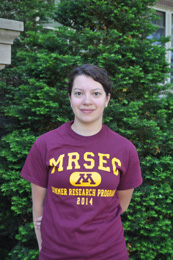
Home Institution: Montana State
Major/Minor: Chemical & Biological Engineering
MRSEC Mentor: Victor Barocas
Planar Biaxial Extension of Porcine Cervical Facet Capsular Ligaments (FCLs) for Insight into Shear Loading and Localized Stress Concentrations
Facet joints are located on the posterior side of the spine and multiple FCLs span from the cervical to lumbar regions. Facet joints include rigid bone and flexible connective tissue, and the different tissues work together to transfer loads across the joint and stabilize the vertebrae. The FCL is the flexible connective tissue that connects adjacent articulating vertebrae and exhibits viscoelastic properties. The FCL is composed of nerve fibers embedded within the aligned collagen fibers that send proprioceptive (position) and nociceptive (pain) signals to the brain. Investigations of this ligament have led to a deeper understanding of its significant role in back pain and whiplash. During this project FCLs will be subjected to planar extension tests with an Instron® bi-axial tester. We aim to determine how porcine cervical FCLs respond to varying loading configurations and rates of loading by analyzing load data and calculating global and local strains.
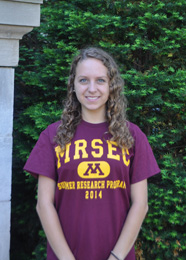
Home Institution: Scripps College
Major/Minor: Physics
MRSEC Mentor: Beth Stadler
Cerium doped Terbium Iron Garnets for magneto-optical applications
Cerium doped Terbium Iron Garnet is a material with magneto-optical properties that make it useful in devices such as optical isolators, which can be used to improve silicon photonics devices by allowing light to pass through photonic circuits in only one direction. The principle behind such non-reciprocal devices is called Faraday Rotation. This is a rotation of the polarization of light when passing through a magneto-optic material under an applied magnetic field. Iron Garnet materials produce this effect and therefore are useful in silicon photonics. The particular material that I am investigating is known as Terbium Iron garnet (Tb3Fe5O12). I am experimenting with introducing various percentages of Cerium into the TIG compound (CeXTb3Fe5O12). , which will be done using the sputtering technique onto quartz and silicon substrates, and then annealing these samples at various temperatures using the RTA (Rapid Thermal Annealer) to discover a material with optimal faraday rotation properties. The samples will be checked for crystallization using EBSD (Electron Backscatter Diffracttion) and XRD (X-Ray Diffraction), and their magnetic properties will be measured using the VSM, as well as magneto-optic characterization to measure Faraday Rotation. We anticipate that increasing Cerium content will improve the magneto-optical properties. Once the optimal material has been developed we can start to design waveguides for use in photonic circuits.

Home Institution: Florida A&M
Major/Minor: Chemistry
MRSEC Mentor: Frank Bates
Microstructure and Mechanical Properties of Block Copolymer Modified Epoxy Resins
From hardwood floor finishing to food packaging, epoxy coatings are widely used today to extend the life of materials that would, otherwise, be susceptible to deterioration (i.e. corrosion). This investigation takes a closer look into toughening epoxy coatings by the inclusion of block polymers at low weight percentages (2 – 5 wt %) with the hopes of creating a more durable coating. The epoxy resin being studied contains a commercially available epoxy monomer (DGEBA) and a curing agent (Jeffamine T-403). When added to the resin, poly(ethylene-alt-propylene)-b-poly(ethylene oxide) (PEP–PEO), the block polymer, will self-assemble into various structures which will toughen the coating by preventing the propagation of cracks. By varying the morphology of PEP-PEO in the resin, tougher coatings can be prepared. Mechanical properties, which are dependent on the thickness of the coating and the morphology of the block polymer, will be determined by various techniques. It has been hypothesized that a worm-like structure would be the most beneficial while still maintaining the integrity of the original resin; that is to say, that the modulus and glass transition temperature will not be sacrificed.
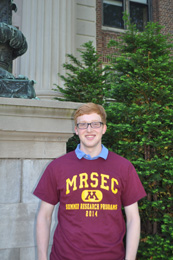
Home Institution: Nebraska Lincoln
Major/Minor: Biology
MRSEC Mentor: Steve Campbell
Development of Diamond-Like Carbon Deposition Processes
Diamond-like carbon (DLC) has recently surfaced as a promising material for biomedical applications. It has many favorable properties, including wear-resistance, biocompatibility, corrosion resistance, hardness, and a low coefficient of friction. Because of these properties, it is being considered as a possible coating for new sensing systems in the brain. A DLC coating could reduce glial scarring and improve durability of these systems. DLC has been deposited using different gas mixtures by the rf-plasma enhanced chemical vapor deposition (PECVD) technique. Using a PECVD system, ellipsometry, wet etching, profilometry, and FTIR, I will be testing the effect of different concentrations of CH4/N2 and CH4/He mixtures on the deposition rates and chemical makeup of the thin films. Once this is complete, I will characterize the film stress and test biocompatibility in the cell culture line.
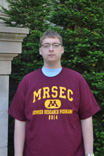
Home Institution: Ohio State
Major/Minor: Chemical Engineering
MRSEC Mentor: Chris Macosko
Determining Interfacial Rheological Properties of Thin Pulmonary Surfactant Films
Neonatal respiratory distress syndrome (NRDS) is a condition in which the lung surfactant of infants is not produced in adequate quantities. Further, acute respiratory distress syndrome (ARDS), a condition in which lung surfactant becomes deactivated giving way to rapid respiratory failure, has a mortality rate of 30-40% and affects over 100,000 people in the U.S. per year. This surfactant consists primarily of the phospholipid Dipalmitoylphosphatidylcholine (DPPC), which consists of two long hydrocarbon chains attached to a hydrophilic head. The pulmonary surfactant, and thus DPPC, exists in the lungs as thin films coating the alveoli, and so characteristics of DPPC as a thin film is significant in the performance of the lung surfactant. It is known that cholesterol levels within pulmonary surfactant in victims of ARDS is significantly elevated, and it is also known that cholesterol has a significant effect on the surface characteristics of DPPC even in very small concentrations. Previous attempts to characterize the surface interfacial rheology of DPPC have failed due to the high surface viscosities exhibited by the surfactant at high surface pressures and low concentrations of cholesterol. The goal of this research is to utilize a new technique to measure interfacial rheology, called the double wall ring. By determining how the interfacial rheology of DPPC is affected by surface pressure, cholesterol concentrations, and fatty acid concentrations, it is hoped that conditions such as ARDS and NRDS may be able to be better treated by adjusting surface rheology in the replacement surfactant via cholesterol and fatty acid concentration.
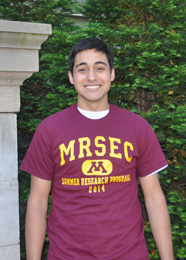
Home Institution: University of Texas Pan American
Major/Minor: Mechanical Engineering
MRSEC Mentor: Uwe Kortshagen
A nanoparticle is defined as a particle that is at least one dimension less than 100 nm. Different elements can be used to make different nanoparticles that are appropriate for the certain applications of the project or experiment; the main elements being used in this project will be silicon and germanium. This project focuses on the use of a spray gun to apply these nanoparticles to a substrate, with the expected future application of being able to easily create solar panels by simply spraying a coating of nanoparticles on a large substrate. Both silicon and germanium are being spotlighted by this project because they both have properties that indicate that they will attract and hold sunlight, while also being safe and non-toxic. My purpose in this project is to automate the spray gun being used. This will allow for the conditions of each test to be effortlessly duplicated which in turn will make it easier for the results to be analyzed and compared to one another.

Home Institution: St. Olaf College
Major/Minor: Physics and Mathematics
MRSEC Mentor: Jian-Ping Wang
Applying the Spin Hall Effect to Magnetic Tunnel Junction Based Nanomagnetic Logic Devices
As the use of MTJ based devices becomes increasingly widespread, one of the limitations of modern magnetic-based computing is the necessity of an external magnetic field for clocking purposes. This limits scalability and energy reduction. However, through the use of logic devices which rely on magnetoresistive elements for read-out, spin transfer torque for writing of information, and the spin Hall effect for clocking we can overcome both of these limitations. Working primarily in the Minnesota Nano Center we will use photolithography, e-beam lithography, ion milling, and metal deposition to fabricate multiple MTJ pillars on top of a tantalum Hall bar. To examine the properties of the materials used we will use a vibrating sample magnetometer and x-ray diffraction in addition to examining the sample optically and using a scanning electron microscope. By measuring the magnetoresistance across the circuit while varying an external magnetic field we hope to observe each MTJ pillar switch from anti-parallel to parallel individually and use these different states to represent logic values of 0 and 1 for use in a majority logic function.
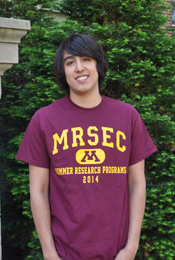
Home Institution: University of Texas Pan American
Major/Minor:
MRSEC Mentor: Dan Frisbie
Aerosol-jet printed electrolyte-gated transistor using SES co-block polymer for application in printed electronics and bio-chemical sensors
Performance optimization and stability analysis of electrolyte gated transistors (EGT) fabricated by aerosol jet printing offers exciting insight into a viable method for high-volume and low-cost manufacturing of transistors for potential application in printed electronics and bio-chemical sensors. Aerosol-jet printing technique will be used to deposit thin films of poly(3-hexylthiophene) (P3HT) p-type semiconductor layer onto a flexible and robust plastic substrate (i.e. PET or PEN) prepatterned with Au electrodes achieved by photolithography. The electrolyte gel layer is composed of polystyrene-polyethylene-polystyrene (SES) co-block polymer and ((1-ethyl-3-methylimidazolium bis(trifluoromethyl sufonyl)amide) [EMIM][TFSA] ionic liquid which functions as a high capacitance dielectric layer. Determination of the claim that SES has an increased ionic mobility and modulus will be verified as a result of the project. Finally, electrical probe and optical microscopy techniques will be used to measure the performance efficiency of the device constructed and characterize the morphology, respectively.
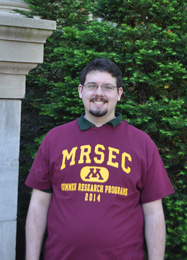
Home Institution: Utah Valley State
Major/Minor: Physics
MRSEC Mentor: Dan Frisbie
Printed Electrolyte Gated Transistors Using N-type Semiconductors
Aerosol jet printing can be used to print a variety of electronic components while conserving materials. There is an interest in creating both P-type and N-type semiconductors in printed transistors to allow for the creation of complementary circuits. The electrolyte gated transistor uses a semiconductor along with an ionic conducting liquid gel that acts as an electrolyte capacitor. We will be looking at ZnO as well as other N-type semiconductors and test them for their performance within a printed transistor. The semiconductor will be printed on a prepared substrate along electrical contacts along with the ion gel and a conductive ink. We wish to see if these N-type semiconductors will perform just as well as their P-type counterparts.
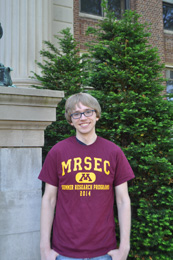
Home Institution: Iowa State
Major/Minor: Materials Engineering/Mathematics
MRSEC Mentor: Renata Wentzcovitch
The ThoM database - A collection of computationally-calculated thermodynamic data for minerals.
Understanding the physical properties of materials at high temperatures and pressures is essential to the field of geophysics. Today, computational methods provide the most accurate approach for interpreting seismic data and modeling mineral behavior under extreme conditions of temperature and pressure. The Virtual Laboratory for Earth and Planetary Materials (VLab), located at http://www.vlab.msi.umn.edu, is a Science Gateway designed to allow distributed, high-throughput computation of materials properties at high temperatures and pressures. Hosted by the Minnesota Supercomputing Institute (MSI), VLab leverages the computational power of grid systems to perform computations using density functional perturbation theory (DFPT). This technique is employed to calculate the vibrational density of states (VDOS) for a mineral. From the VDOS, VLab can extrapolate a variety of thermodynamic quantities by applying the quasi-harmonic approximation (QHA). These include the isochoric and isobaric specific heat (CV and CP), the isothermal and adiabatic bulk modulus (KT and KS), the thermal Grüneisen parameter (γ) and the coefficient of thermal expansivity, (α) as functions of pressure and temperature. VLab also allows direct calculation of thermodynamically relevant quantities such as entropy (S), enthalpy (H) and Helmholtz free energy (F). Users may control the range of temperatures and pressures and may choose the equation of state according to which values are calculated. Resultant data can then be tabulated, plotted or downloaded from the VLab website.
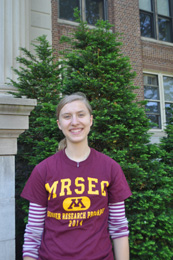
Home Institution: Iowa State
Major/Minor: Materials Engineering/Bioengineering
MRSEC Mentor: Theresa Reineke
Polymerization of diblock copolymers containing a zwitterionic arginine moiety
Some cationic polymers used as nucleic acid delivery vehicles can exhibit high cellular toxicity (such as JetPEI). Recent literature shows that polymers containing zwitterionic moieties or blocks can be less toxic alternatives for DNA delivery applications, while showing high efficiency in uptake. We employ multiple methods to synthesize and purify a methacrylate-based zwitterionic monomer and polymerize it using reversible addition- fragmentation chain transfer (RAFT) polymerization. The chosen monomer is a derivative of the amino acid arginine, which is synthetically modified to be compatible for RAFT polymerization. RAFT polymerization conditions are determined to reliably produce diblock copolymers of zwitterionic arginine monomer and polyethylene glycol (PEG). Nuclear magnetic resonance (NMR) spectrometry was used to analyze synthesized products and determine purity. Size exclusion chromatography (SEC) was used to determine the molecular weight (Mw) and dispersity (Ð) for the synthesized polymers.

Home Institution: Dillard
Major/Minor: Biology/ mathematics
MRSEC Mentor: Victor Barocas
Investigation of the mechanical properties of collagen-HA gels
Collagen is a unique triple helix protein that serves as a medium for cell attachment and macromolecule anchoring. There are several types of collagen (types I-IV) abundant in tissues as long fibrils to provide and maintain tissue structure. Collagen does not swell or shrivel when put into saline solutions or distilled water, unlike hyaluronic acid. Hyaluronic acid is a carbohydrate that shrivels in saline solutions and swells in distilled water. These substances are of interest because they are the main components to tissue, not including cells. A collagen-HA gel can be made for tissue modeling; the goal is to obtain the basic mechanical properties of this gel. Particularly, the aim is to observe a modulus to characterize the elasticity of collagen-HA gels. This will be done by swelling the collagen-HA to various sizes then performing a micro-pipette aspiration. In a micro pipette aspiration, the swollen collagen is subjected to applied pressure caused by the micropipette's suction; due to this pressure, the gel will deform and be taken into the pipette. The extent of deformation can be measured and interpreted to reveal the elasticity modulus of collagen-HA gels.
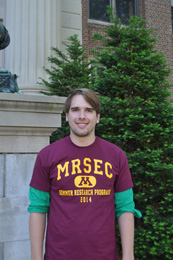
Home Institution: Bethel
Major/Minor: Physics and Computer Science
MRSEC Mentor: Sang-Hyun Oh
Fabrication of Nanoplasmonic Devices
Nanohole arrays patterned in noble metal films can function as optical biosensors, because the optical transmission through the nanoholes changes sharply with refractive index changes near the metal surface. Smaller nanoholes have sharper resonance peaks, making a better sensor. At the same time, smaller nanoholes have lower transmission efficiency. Template-stripped Ag nanohole arrays of varying diameters were used in combination with an ultra bright white light source to look at the difference in the optical response of nanoholes with a diameter of 80 nm in comparison to nanoholes with diameters of 100 and 120 nm. To achieve the resolutions needed for the nanohole arrays, electron beam lithography was used to pattern them. Electron beam lithography was also used to manufacture a mask on a suspended nitride film for metal deposition. Using this technique allows the user to manufacture a number of chips with a mask, minimizing the use of the electron beam. The devices created by this process used metal-oxide-metal tunnel junctions. The resonant frequency of this plasmonic device can be tuned by changing the dimensions of the metal grating.
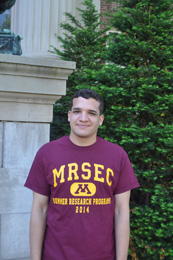
Home Institution: University of Puerto Rico Mayaguez
Major/Minor: Chemical Engineering
MRSEC Mentor: Eray Aydil
Reduction of Oxygen Impurities in ZnS Synthesized by Chemical Bath Deposition
Solar cells are environmentally friendly devices that convert solar energy into electricity. This work will focus on n-type semiconductors for thin film solar cells. Currently, CdS is the most commonly used n-type material. Unfortunately, CdS has a poor blue spectral response due to its narrow band gap, and there is a concern with the toxicity of Cd. We aim to replace CdS with ZnS, a non-toxic alternative, with a wider band gap (3.8 eV) compared to the band gap of CdS (2.4 eV). Additionally, ZnS can form an ideal conduction band offset with larger band gap absorbers like copper indium gallium aluminum diselenide (CIAGS). However, ZnS has high oxygen impurities that may increase the electron affinity of the resulting film and can create a non-ideal band alignment with p-type absorbers. ZnS will be synthesized using chemical bath deposition. The goal will be to reduce the oxygen content in ZnS films by adjusting the reagent concentration, pH and temperature of the deposition. Auger electron spectroscopy (AES) will be used to determine the oxygen content and x-ray diffraction will be implemented to evaluate the film crystallinity.
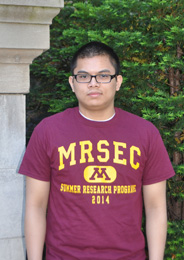
Home Institution: UMass
Major/Minor: Chemical Engineering
MRSEC Mentor: Kevin Dorfman
Linearization of DNA in Nanochannels and Applications in Optical Mapping
Conventional DNA sequencing has yielded relatively accurate maps of how base pairs are ordered in various genomes. However, the process encounters difficulties in sequencing large gaps in genomic information, as well as genomic variations. Optical mapping of DNA has emerged as a viable technology to help with these deficiencies in genomic sequencing. Rather than using a large population of short sequence reads to derive a final sequence, optical mapping uses fluorescent imaging of large (~10 kbp-1 Mbp), linearly arranged, individual DNA strands to view large scale patterns that would be lost with traditional sequencing. The difficulty with optical mapping is that a strand of DNA is very unlikely to be in a linear state, unless it is confined to it. The goal of this lab is to study how a strand of DNA behaves while confined by a nanochannel, specifically how it extends in response to the variation of width of the channel. We intend to use nanochannel devices etched in fused silica substrate by e-beam lithography to explore this subject. Because individual DNA strands are difficult to confine, slight pressure, along with etched microchannels, will feed the DNA into the nanochannels. We expect that channels with the same depth and width will exhibit more precise lengthening properties.

Home Institution: Allegheny College
Major/Minor: Physics/ Math and Writing
MRSEC Mentor: Tim Lodge
Varying ratios of polystyrene sulfonate chains and PDMAEMA micelles to understand complex formation
Polymer-micelle complexes are currently under heavy investigation due to their potential applications in targeted drug delivery and gene therapy, yet the dynamics of the complex formation is still relatively unstudied. By varying the ratios of polystyrene sulfonate chains and cationic micelles of PDMAEMA at pH three, we aim to create a variety of complex configurations which can be characterized using static and dynamic light scattering. Additionally, SLS and DLS give us information regarding the hydrodynamic radius, distribution of sizes, and radius of gyration of these complexes.
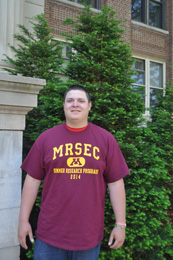
Home Institution: College of Menominee Nation
Major/Minor: Mechanical Engineering
MRSEC Mentor: Cari Dutcher
Flocculation of bentonite solutions using Cationic poly-acrylamide
Flocculation is a prevalent process in all forms of water treatment to aid in separation. Polyelectrolytes, or water-soluble polymers with ionizable groups, are useful because of their increased efficiency over mineral coagulants. However, due to the complex nature of flocculation, treatment plants have to use more polymer than needed, resulting in higher costs. We are using the commercially available FLOPAM cationic poly-acrylamide from SNF INC. Bentonite, an inorganic clay, is used to simulate source water. We are studying the effect of pH, ionic strength, and the presence of natural organic matter (NOM) on flocculation efficiency using standard jar test procedures. This information will be used to further characterize the aggregates (flocs) that are formed using a Taylor-Couette cell. Our goal is to optimize the treatment of water through flocculation to reduce costs.
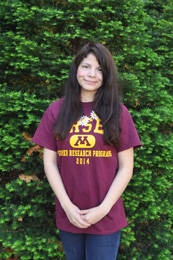
Home Institution: University of Texas Pan American
Major/Minor: Chemistry/BUSA and Biology
MRSEC Mentor: Efie Kokkoli
Multifunctional peptide-amphiphile hydrogels
Nanofiber hydrogels are emerging as important class of tissue engineering scaffolds to mimic natural extracellular matrix (ECM) found in tissues. These scaffolds can be designed to match both the physical as well as biochemical characteristics of the ECM. Peptide ligands that mimic ECM components such as collagen, fibronectin, or growth factors can be synthesized and used to create the building blocks necessary for the formation of nanofibers. We propose the design, synthesis and characterization of peptide-amphiphiles that mimic the above ECM components. Further, these peptide-amphiphiles will be used to form nanofibers in aqueous/physiological conditions and the resulting hydrogels will be evaluated as scaffolds for adhesion and proliferation of cells in-vitro.

Home Institution: Grambling
Major/Minor:
MRSEC Mentor: Victor Barocas
The Centers for Disease Control (CDC) has reported, “One in 10 American adults, more than 20 million has some level of [chronic kidney disease] CKD.” Kidney disease is recorded to be United State 9th leading cause of death. The kidneys are used to regulate the excess fluid or waste throughout the body. They help to maintain the balance with our salt intake. There are five different types of kidney failure. They can be caused by a multitude of things such a direct trauma to kidneys or insufficient blood flow. Some kidney diseases involve changes in permeability. Using an apparatus called the manometer allows us to calculate the permeability of materials such as collagen gels or filter papers. The tubing of the manometer is filled with a fluid, providing gravitational pressure to measure the hydraulic resistance between the entry point of the substance and the exit point. In my efforts this summer, I hope to improve my knowledge of the kidney and increase my knowledge about seeking higher education.
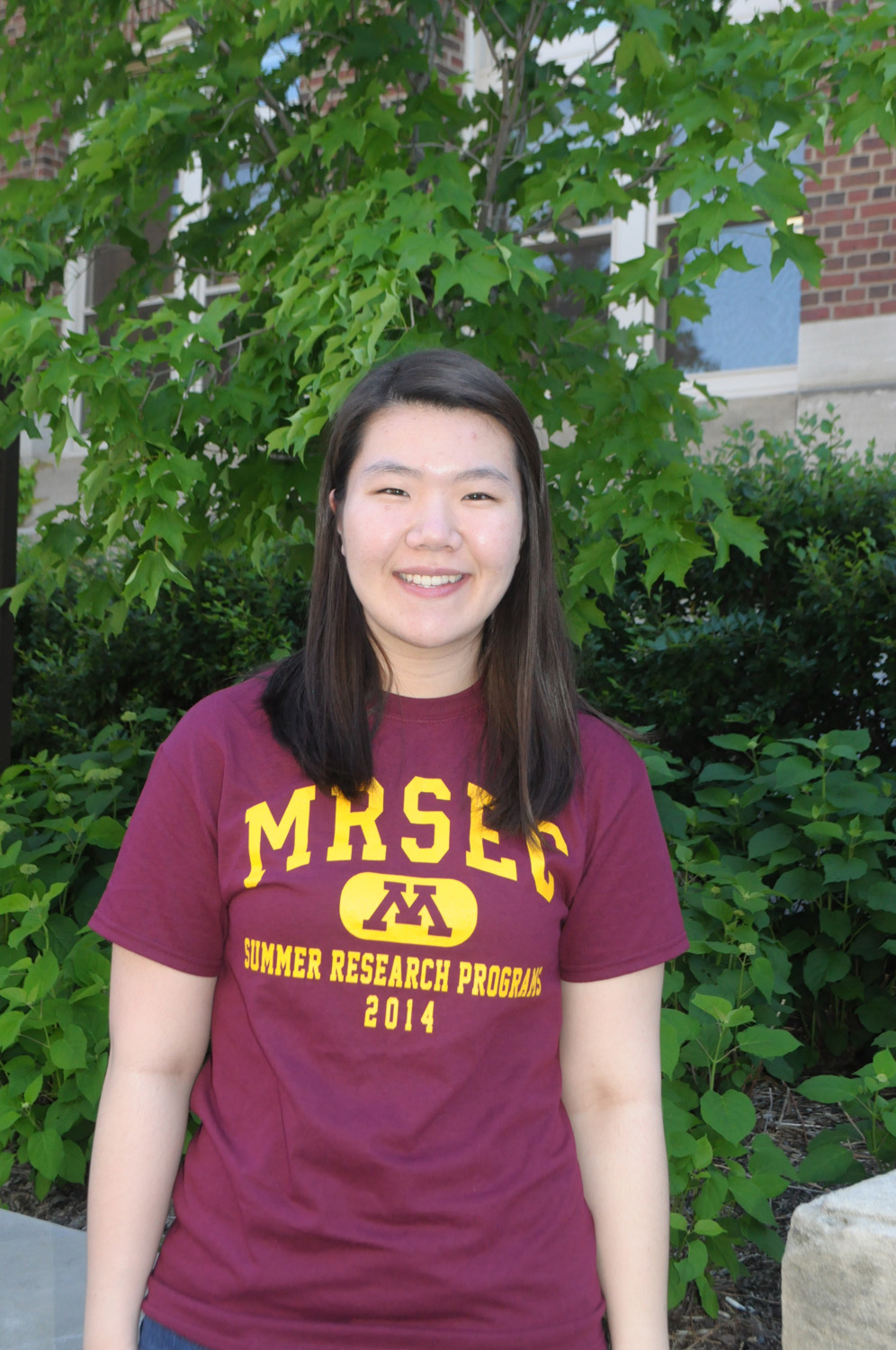
Home Institution: Northwestern
Major/Minor: Chemical Engineering
MRSEC Mentor: Andre Mkhoyan
Analysis of Nanoindentation Experiments to Study Indentation Size Effects
Size effect is an interesting and complex phenomenon that generally results in an increase in strength and toughness with a decrease in size of material structure or volume under strain. A better understanding of size effects on properties of materials of small volume is vital to advancements in nanotechnology. Size effects can be studied with nanoindentation experiments, where mechanical properties such as the elastic modulus and hardness can be determined by measuring the depth of penetration and indenter load. Nanoindentation tests of standard engineering materials such as Nitronic 50 stainless steel, silicon, and iron-3% silicon will be executed to determine hardness as a function of depth of penetration. Furthermore, electron backscatter diffraction will be utilized to better understand the material structure. Analysis of the experimental data will provide a stronger comprehension of mechanical properties of small volume systems and indentation size effects.
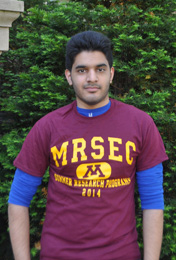
Home Institution: University of Texas Pan American
Major/Minor: Mechanical Engineering
MRSEC Mentor: Uwe Kortshagen
ALD Infiling study
Semiconductor Nano crystals have attracted considerable interest because of its many possible applications with respect to light emitting devices and displays, solar cells, Nano electronics, luminescent markers and the list goes on. For these semiconductors Nano crystals to be functional in devices they need to be coated onto a film and currently there are very few methods that make high efficiency films. For energy to be conducted through the crystals they need to be as close together as possible however when dealing with Nano particles it is difficult to coat the films in such a way that these Nano crystals are already close together. The Atomic layer deposition (ALD) infilling process seeks to alleviate that problem by filling the gaps between the semiconductor Nano crystals with another conductive substance to allow electrons to move freely from particle to particle. The study will be focused on improving the film density by altering the recipes used in the ALD when infilling our Nano crystal films to get the best film density to allow for the most efficient transfer of electrons. The recipes in the ALD have a number of parameters that we will be alter in working towards improving the film density, mainly the number of cycles of substrate we need to the best infill onto the Nano film. We will be working with Zinc oxide as our infilling substrate and we will be using Silicon and germanium based nano particles in our tests with the ALD and at the end we will compare the results of both combinations. By finding the appropriate number of cycles of Zinc Oxide being deposited we should see the best possible film density for conduction across both Nano films.
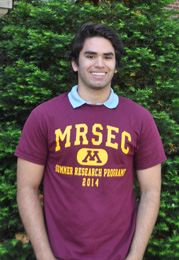
Home Institution: University of Texas Pan American
Major/Minor: Chemistry (major), Spanish (minor)
MRSEC Mentor: Efie Kokkoli
Target Drug Delivery
A common problem with cancer chemotherapy is the off-target toxicity levels that most treatments cause. Off-target toxicity occurs when the drug that is delivered affects both healthy cells and diseased cells, which results in a number of side effects including nausea and hair loss. A new way to deliver drugs that promises to be more effective in treating or combating cancer is to use nanoparticles to carry drug to the diseased cells. A particular type of nanoparticle used to deliver drugs are micelles, created by the self-assembly of amphiphilic molecules. We plan to synthesize single stranded DNA aptamer-amphiphiles that will self-assemble into spherical micelles to help deliver drugs to the cancer cells. The spherical micelles will hold the chemotherapeutic drug inside while the DNA aptamer will be present on the outside of the micelles and will help guide the drug towards the cancer cells, thus reducing the amount of off-target toxicity while increasing the amount of drug delivered to the diseased cells.
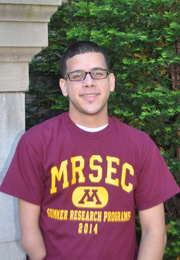
Home Institution: University of Puerto Rico Mayaguez
Major/Minor: Chemical Engineering
MRSEC Mentor: Paul Crowell
Detecting Spin Accumulation at a Ferromagnet-Semiconductor Interface
It is believed that by understanding the secrets of spin transport and spin detection we will be able to increase memory storage and decrease space occupancy of future electronic devices. The main idea of the research is to understand and improve spin detection. One of our goals is to try to make our devices smaller while keeping them functioning, which we hope to achieve using electron beam lithography. We will also be doing device imaging with the scanning electron microscope (SEM) seeking valuable information including topographical, morphological and compositional properties. Some magnetic characterization will also be done using the VSM magnetometry technique to measure hysteresis loops.
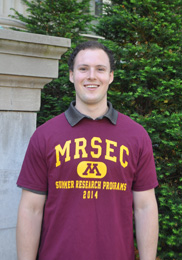
Home Institution: CSU Channel Islands
Major/Minor:
MRSEC Mentor: Patrick Alford
Microfabricated Cell Array Device for Screening of Metastatic Potential
Metastasis is a complex cell migration process where a cancer cell leaves its primary tumor site to establish a secondary tumor site, causing greater than 90% of cancer related deaths. One way to quantify the cell migration process has been to track single cells plated on a dish. However, this method is low-throughput and requires costly live microscopy chambers. Here we develop a high-throughput cell migration assay by employing microfabrication techniques to develop a method to capture single cells and place them in an organized array. We will quantify cell migratory behavior by quantifying the disorder of the initial organized array. It is well known that the migration of cancerous cells is dependent upon the interactions between the cells and their microenvironments. Thus we will validate our device by characterizing the migration of cells on substrates of varying stiffness, corresponding to how a metastatic cell detaches from the dense tissue of a tumor, and invades the spongy tissues surrounding the tumor. Upon completion of this project, the device will be usable as a diagnostic tool for rapid high-throughput analysis of metastatic potential of biopsied tumor cells.
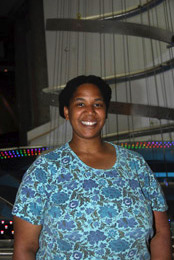
Home Institution: Minneapolis Edison
MRSEC Mentor: Kevin Dorfman
Methods for Incorporating Research into the High School Classroom
Nationwide, there is a push for more inquiry in the classroom – in all subjects, not just science classes. Teachers undergo training regarding the nature of inquiry and learn how to adapt their curricula to fit these new models of instruction. In science, where there should already be an inquiry focus to teaching, many teachers are still learning how to incorporate inquiry into their classrooms. There are many reasons for this lag, but they generally stem from teachers lack of familiarity with basic inquiry of science – scientific research. Quite a few teachers have not spent any appreciable time in a research lab, and are therefore uncomfortable with incorporating student-led research into their curriculum. This lesson allowed different levels of student research to be incorporated into the high school classroom, challenging all students within their own zone of proximal development. Average students and those with learning disabilities were challenged to apply content knowledge to well-defined scenarios. More advanced students conducted more independent research to solve more complex teacher-identified problems.
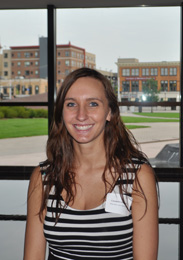
Home Institution: White Bear Lake High School
MRSEC Mentor: Christy Haynes
Increasing the Accessibility of High School Laboratory Investigations by Utilizing Familiar and Common Technologies
Optical measurement experiments are common in advanced high school chemistry courses. These experiments generally require expensive spectrophotometers and colorimeters making them inaccessible to some classrooms. Even if schools have access to such equipment, they may be less effective for student learning due to the “black box” nature of the equipment. A kinetics experiment that utilizes smartphones or tablet devices and studies the fading of crystal violet by reaction with sodium hydroxide was developed. This use of smartphone or tablet devices was extended to an experiment that studies the concentration of gold nanoparticles in a mesogold mineral supplement. Advanced Placement Chemistry students from White Bear Lake High School participated in the development of the kinetics experiment and a field trip experience in which they applied their knowledge from the kinetics experimentation to the nanoparticle experimentation. The use of familiar technologies increased student engagement, participation, and learning during the laboratory investigations.

Home Institution: Breck
MRSEC Mentor: Chris Hogan
Research Experience for High School: Cloud in a Bottle
Cloud condensation nuclei are small particles in the atmosphere necessary for the formation of water droplets that make up clouds. Sulfuric acid (H2SO4) is known to be an important molecule in the formation of cloud condensation nuclei. Sulfuric acid is produced in the atmosphere when sulfur dioxide emissions from the burning of fossil fuels react with water vapor in the air. Dimethylamine (DMA) is a molecule emitted into the atmosphere by anthropogenic sources such as cattle farming and waste treatment. When DMA and H2SO4 interact, they may enhance the formation of cloud condensation nuclei and subsequent growth of particles from water uptake in a humid environment. This investigation aims to shed light on the formation of cloud condensation nuclei in the nanoscale (∼2- 6 nm) in order to better understand how these aerosols contribute to cloud condensation nuclei, cloud formation, and climate. To incorporate aspects of this investigation into my chemistry classroom, I have developed a project combining authentic laboratory research with the study of the effects of aerosols on cloud formation. Students will research, design and construct a cloud chamber made from inexpensive materials that are readily available. They will collaborate across disciplines to design and build the cloud chamber, and then work with sixth grade students to design a procedure that will be used to test the effects of different aerosols on cloud properties.

Home Institution: Clara Barton Open School
MRSEC Mentor: Alon McCormick
Food Grade Oil Dispersant Effectiveness Testing
Effectively managing oil spills in an open sea environment presents mounting challenges to scientists and engineers both in government agencies and in oil companies. When used appropriately, chemical dispersants can be one of the tools available for oil spill response teams to use. The decision to use chemical dispersants requires an interdisciplinary cost-benefit assessment of the net ecological and environmental impact. Dispersants formulation and action, however, still remain underdeveloped. Moreover, understanding dispersants is also important in industries related to food, agricultural, and pharmaceutical products.In this research on dispersant effectiveness, we examine the influence of dispersant composition on dispersion effectiveness. The experiments are done with a view to modifying it for replication by middle school STEM students.
UMN MRSEC
435 Amundson Hall, 421 Washington Ave. SE, Minneapolis, MN, 55455
P: 612-626-0713 | F: 612-626-7805